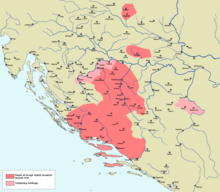Hrvatinić
| Hrvatinić | |
|---|---|
King of Bosnia (titular) | |
| Estate(s) | Lower Edges, Western Sides in Bosnia, Dalmatia |
| Dissolution | 1476 |
| Cadet branches | Vojsalić, Dragišić |

The House of Hrvatinić was a
Background
The family can be traced from the second-half of the 13th century and were cousins and relatives of the Croatian noble Šubić family.[A][2] It is considered that in the beginning had estates in the "Donji Kraji" (English: Lower Ends), specifically in župa Banica with town Ključ, Vrbanja with town Kotor (Kotor Varoš) and Zemljanik with town Greben as well as Glamoč.[2]
History
The family started to grew in power during Stjepan (d. before 1301) whose only surely known son was named as Hrvatin.[2][3] The family's eponymous founder was Hrvatin Stjepanić (fl. 1299–1304), a count and holder of possession in parts of "Donji Kraji" (English: Lower Ends) and "Zapadne Strane" (English: "Western Sides"), and a vassal of Croatian magnate Paul I Šubić of Bribir.[4] Hrvatin's sons was part of a coalition of Bosnian and Slavonian nobility that revolted against Mladen II Šubić of Bribir between 1316 and 1317.[5]
From around 1322 the family submitted to the
In c. 1387, while loyal to Tvrtko I, they supported rebellion in
Religion
Basic expression of loyalty and affiliation was with the Catholic Church although in the short period of early loyalty to the Bosnian Ban and King showed support to the Bosnian Church.[2]
Lineage
- Stjepan or Stipan (Latin: Stephan; died before 1301),[8] according to F. Šišić possibly knez in Donji Kraji, possibly as early as 1244.[9]
- Latin: Horvatinus, Huruatin; fl. 1299–1304), knez (count) in Donji Kraji of Bosnia (de inferioribus Bosne confinibus[4]) and vassal of Paul I Šubić of Bribir.[10][11] Believed by F. Šišić to have died around the same time as Paul I (1312).[12] He had three sons.[12]Called Hrvatin Stjepanić or Hrvatin Stipanić in historiography.
- Latin: Vlkosslaus; fl. 1315–1326), issued a charter in 1315 in Sanica.[9] In ca. 1326, Ban Stjepan II in a land grant mentioned that Vukoslav "had left the Croatian lord".[13] Served as Knez of Ključ (fl. 1325).[14] Married Jelena, the daughter of Knez Kurjak.[15]
- Vlatko (fl. 1364)
- Pavao Hrvatinić (fl. 1323–1332)
- Grgur (fl. 1357)
- Vladislav (fl. 1357)
- vojvoda (transl. duke) by Ban Tvrtko I.[16]
- Hrvoje Vukčić Hrvatinić (1350–1416), Grand Duke of Bosnia (1380), Knez of Donji Kraji and Duke of Split (1403) His sister Resa Vukčić princess of Split was married to Knez Batalo Šantić.
- Vuk Vukčić Hrvatinić
- Vojislav Vukčić Hrvatinić
- Dragiša Vukčić Hrvatinić
See also
Notes
- ^ Hrvatin Stjepanić is called in 1299 by Charles II of Naples as "Hrovatinus comes, nec non filii et fratres eius, consanguinei et cognati virorum nobilium Pauli, bani Croatorum nec non Georgii et Mladeni, fratrum" (of Paul I Šubić of Bribir and his brothers George I and Mladen I Šubić),[9] while by Paul I Šubić as "compatrem nostrum dilectum et fidelem" (1304) and "cognati nostri dilecti et fidelis" (1305).[18][19]
References
- ^ Hrčak.
- ^ Miroslav Krleža Lexicographical Institute
- ^ Croatian Encyclopaedia (2011), Hrvatinići
- ^ a b Klaić 1989, p. 193.
- ^ Fine 1994, p. 211.
- ^ Fine 1994, p. 278.
- ^ a b Fine 1994, p. 397.
- ^ Šišić 1902, p. 7.
- ^ a b c Šišić 1902, p. 243.
- ^ Šišić 1902, pp. 7, 9, 243.
- ^ Klaić 1989, p. 185.
- ^ a b Šišić 1902, p. 9.
- ^ Ančić 1997, p. 113.
- ^ Šišić 1902.
- ^ Ančić 1997, p. 135.
- ^ Fine 1975, p. 107.
- ^ a b Kurtović 2009, p. 59.
- JAZU: 80, 96.)
{{cite journal}}: Cite journal requires|journal=(help - ^ Halilović, Nermina (2013). "Historiografski značaj latinske isprave bana Pavla Šubića i njegovih sinova knezu Hrvatinu Stjepaniću od 21. februara 1305. godine". Glasnik arhiva i Arhivističkog udruženja Bosne i Hercegovine (in Bosnian) (43): 204–219. Retrieved 6 November 2023.
Sources
- Ančić, Mladen (1997). Putanja klatna: Ugarsko-hrvatsko kraljevstvo i Bosna u 14. stoljeću. Acad. Scientiarum et Artium Croatica. ISBN 978-953-154-308-8.
- ISBN 978-0-472-08260-5.
- ISBN 978-0-914710-03-5.
- ISBN 978-86-399-0104-2.
- ISBN 978-9958-649-01-1.
- Šišić, Ferdo (1902). Vojvoda Hrvoje Vukčić Hrvatinić i njegovo doba. (1350-1416): s jednim tlorisom i zemljovidom te s četiri redoslovne table. Izdanje "Matice hrvatske".
